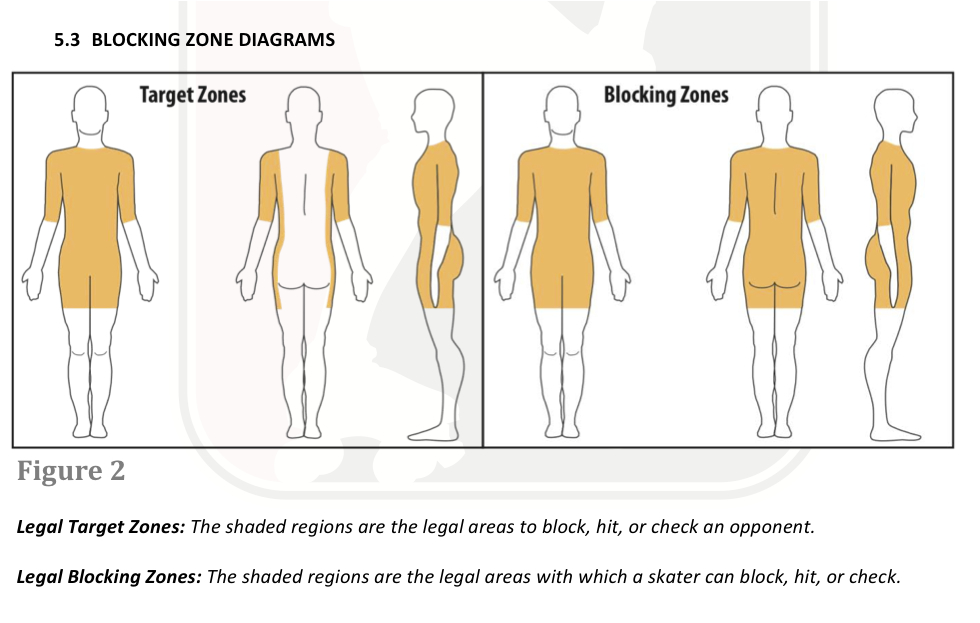The latest full rule set is downloadable at the WFTDA web site.
You can listen and download audio of the ruleset (in progress) here:
The objectives of roller derby are fairly simple. Each team fields a single point scoring skater (“Jammer”) whose object is to lap as many opposing skaters as they can.
The remaining skaters who aren’t scoring points work both on offense and defense at the same time to block the opposing jammer and to clear a path for their own jammer.
There are two halves in a BOUT. Each half is 30 minutes long and has an unlimited number of jams. The maximum length of a jam is 2 minutes. There are 30 seconds between jams – if the players are not on the floor at the end of 30s, the jam will start without them and their team will play short of that player/her position.
SETUP
- Each team fields five players at a time; four are BLOCKERS and one is the JAMMER (point scorer).
- The four blockers from each team line up together and form a PACK, while the two jammers line up on the jammer line 30 feet behind the pivot line.
- The “pack” is the largest group of blockers containing members from both teams. The “Engagement Zone” exists 20 feet in either direction from the nearest pack member. A skater must be in the Engagement Zone in order to block or assist or earn “Out of Play” penalties.
- If there is no pack then no skater can engage or assist another player from any team. There are Out of Play penalties for destroying the pack as well as failing to reform the pack once it is destroyed.
- The skater wearing the star on her helmet is the jammer. The skater wearing the stripe on her helmet is called the PIVOT. The pivot is the only player that can receive the jammer helmet cover during a star pass and controls the pack.
- On the whistle (1 short blast), the pack begins moving and the jammers take off. 4 short whistle blasts indicate the end of a jam.
- On the first lap, the jammers earn no points, but the first jammer to legally pass each blocker on the opposing team and clear the pack is called LEAD JAMMER. The jammer ref will point to the jammer and hold up an “L” if they have attained lead jammer status.
- The Lead Jammer can strategically end the jam before the two minutes are completed by repeatedly gesturing with their hands on their hips. Jammers lose Lead Jammer status if they are sent to the penalty box during the jam.
- If a Jammer goes out of bounds for any reason before they reach the Engagement Zone, (20ft from the last skater in the pack), she ineligible to be Lead Jammer for that jam.
- If both jammers commit penalties on their first lap, there is no Lead Jammer in that jam and it will run for the full 2 minutes.
SCORING
- After a jammer completes their initial lap, they score 1 point for each opposing skater they pass and automatically scores points against opposing skaters in the penalty box.
- A jammer earns an extra point when they lap the opposing jammer (aka Grand Slam).
- Jammer referees hold up fingers at the conclusion of each lap for points just earned.
- A jammer may pass the star to their pivot, but will lose lead jammer status (if they had it) and attempts this maneuver. The new jammer begins scoring immediately, and if the opposing jammer does not have lead jam status, the jam will last a full 2 minutes.
PENALTIES AND THE PENALTY BOX
- Blocking with forearms, hands, elbows, or a helmet
- Tripping, kicking, or blocking with feet or legs or blocking to the back or head
- Blocking while 20 feet ahead of or behind the pack (“out of play”)
- Intentionally destroying the pack, such as by taking a knee or leaving the track in a way which rendering the remaining players ineligible to block
- Blocking while out of bounds, or blocking a skater who is out of bounds (outside the track boundaries)
- Skating counter-clockwise out of bounds to get around other skaters (“cutting the track”)
- Illegal procedures: false starts, too many skaters on the track
- Hitting in a counter-clockwise direction is a major (“direction of game play”)
Referees determine the game impact of each illegal action – was it no impact or major? For example, an illegal back block that causes a skater to stumble would be a no impact; causing her to fall would be a major.
- A major penalty costs one minute of jam time in the box, served immediately.
- Refs point skaters to the box with one finger to indicate a major.
- A jammer in the box is released immediately if the other jammer also lands in the box. The second penalized jammer serves only as much time as the first jammer (i.e. Blue has served 27s of their 60s penalty when Red is sent to the box. Red will serve 27s also)
- Accumulating 7 trips to the penalty box results in FOULING OUT of the game
- Skaters reentering the pack from the penalty box must enter at the back of the pack.
LEGAL BLOCKS
- Any player may engage an opposing player’s shoulder to upper thigh, chest and upper torso. Importantly, the player may not hit/contact the other player’s back.
- The player can initiate contact with her booty, back, hips, torso, and arm from her shoulder to just above the elbow.
Image courtesy of WFTDA rule-set document.
Confused at a bout? Don’t be shy about asking a neighbor in the stands!







